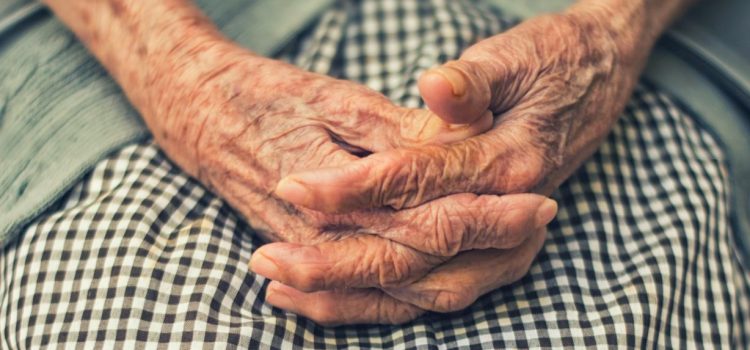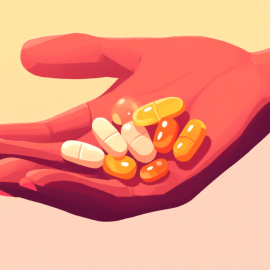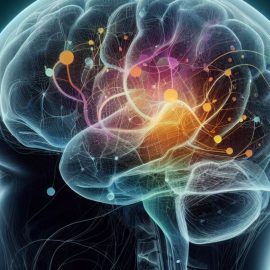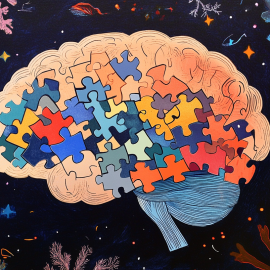

This article is an excerpt from the Shortform book guide to "Ageless" by Andrew Steele. Shortform has the world's best summaries and analyses of books you should be reading.
Like this article? Sign up for a free trial here.
What are the causes of aging? What systems in the body speed up the aging process?
In Ageless, Andrew Steele writes that many biological processes cause the symptoms of aging. To figure out how aging happens, scientists need to understand these processes.
Keep reading to learn about the processes that contribute to aging and what science is doing about them.
Aging Process #1: Harmful Substances Accumulate
Steele writes that when substances that should be destroyed or recycled accumulate in your body instead, dysfunctions occur. Two materials that can act as the causes of aging are senescent cells and malfunctioning proteins.
Senescent Cells Accumulate Throughout the Body
Senescent cells—cells that are damaged or stressed but haven’t died—accumulate as you age. Steele explains that each day, hundreds of millions of cells in your body die. Many die through apoptosis, a “self-destruct” process that happens when a cell experiences too much damage or stress. But if apoptosis doesn’t happen, the cell stays alive and stops dividing, entering a state that scientists call “senescence.” Senescence has some benefits, like stopping pre-cancerous cells from making copies of themselves. But Steele explains that senescent cells emit inflammatory signals to tell your immune system to remove them, and these damaging signals turn other cells senescent or cancerous and increase risk of disease.
The potential fix: Steele explains that scientists are working on interventions (called senolytic treatments) that cause senescent cells to die. The first senolytic treatments will target specific medical conditions that senescent cells are known to cause, and Steele predicts that preventative treatments will follow. Other treatment ideas include senomorphics, which leave cells in their senescent state but reduce the harm done by their inflammatory signals, and epigenetic reprogramming, a process that could convert senescent cells back to normal cells.
Malfunctioning Proteins Build Up
Another substance that builds up as we age is protein. Proteins are the building blocks of all of your tissues. As they malfunction, they accumulate and cause harmful effects.
Steele explains that scientists have studied three ways malfunctioning proteins accumulate in tissues around the body.
1) A slowdown in autophagy, a process that removes and recycles old protein molecules. As you age, leftover pieces of proteins accumulate and impair autophagy. Steele notes that this plays a role in Parkinson’s disease, where deposits called “Lewy bodies” form in the brain.
The potential fix: Steele writes that dietary restriction (eating fewer calories) stimulates autophagy. Scientists have also found drugs, called dietary restriction mimetics, that simulate the effects of dietary restriction without a change in diet. Plus, they’re developing ways to boost autophagy directly with bacteria that help cells to break down waste.
2) A buildup of amyloids: misshapen protein molecules that form when proteins fold incorrectly. Amyloids stick together and form plaques in your organs and tissues, leading to Parkinson’s disease, amyotrophic lateral sclerosis (ALS), and Huntington’s disease.
The potential fix: Steele writes that we could use antibodies—proteins that mark viruses or bacteria that the immune system needs to destroy—to signal the immune system to clear amyloids. Alternatively, we could use specific antibodies called catabodies that can destroy the proteins themselves. A third option would be to use a virus, M13, that breaks apart the proteins implicated in Alzheimer’s, Parkinson’s, and Huntington’s diseases.
3) The accumulation of adducts. Adducts are proteins formed when reactive sugars and oxygen attach themselves to your proteins and stop them from functioning properly. Adducts are to blame for diminishing bone strength and stiffening blood vessel walls as you age. And when collagen—a protein in your skin and blood vessels—gets more sugary and oxidized, it stiffens, which causes visible aging in your skin and stiffening in your arteries, lungs, and tendons.
The potential fix: Steele explains that drug treatments could remove sugar molecules from collagen and make the tissue flexible again. Alternatively, scientists could develop treatments to prompt the body to destroy and replace old collagen.
Aging Process #2: Crucial Systems Degrade
A second process involved in aging is the degradation of important systems in your body. Steele writes that when processes become less effective with age, the changes can wreak havoc. In this section, we’ll look at three systems where this loss of effectiveness does a lot of harm: your stem cells, your immune system, and your microbiome.
Stem Cells Die or Become Less Functional
As you age, many types of cells in your body die or become less effective. Steele writes that this is particularly problematic with stem cells. Most of your cells are specialized, and when they divide, they create two of the same kind of cell. But stem cells can create different types of cells, which enables them to replenish a variety of cells around your body. When stem cells become less effective, your bones become more fragile and your senses less sharp. Stem cell loss also plays a role in diabetes, certain kinds of blindness, and Parkinson’s.
The potential fix: Steele explains that transplanting stem cells—a process called a bone marrow transplant or a hematopoietic stem cell (HSC) transplant—could replenish your supply of these versatile cells. Scientists have also learned to generate induced pluripotent stem cells (iPSCs), enabling mature cells (like your skin cells or blood cells) to turn into any cell type.
Your Immune System Becomes Less Capable
Your immune system, which protects you from infection, is another system that becomes less functional as you age, leading to a variety of harmful repercussions. Steele explains that this decline affects many components of your immune system.
1) Your thymus deteriorates. Your thymus is an organ that produces T cells, the white blood cells you need to fight infections. It begins to decline in volume and function when you’re a child and halves in size every 15 years.
The potential fix: Sterilization stops the thymus’s decline, but Steele points out that this isn’t a practical treatment. Growth hormones or gene therapy could rejuvenate the thymus, and scientists think it might be possible to use stem cells to grow a new thymus.
2) Cells that remember past infections impair your body’s ability to fight new infections. Steele explains that memory T cells and B cells become specialized to an infection. These cells—such as the ones specialized to fighting a common virus called cytomegalovirus (CMV)—remain in your immune system for years afterward. As you age, you have fewer T cells that aren’t specialized. The ones that are specialized use up resources and cause your immune system to fixate on old infections, making it less effective against new ones.
The potential fix: Steele writes that scientists could eliminate these single-minded cells via processes that kill senescent cells. Other ideas include targeting cells that have DNA damage or extending the telomeres of aging memory T cells and B cells.
3) Your immune system gets less efficient at finding and destroying tumors, which is why cancer is more prevalent in older people.
The potential fix: Steele explains that an HSC transplant could reboot your entire immune system and boost its performance at destroying cancerous cells—but wiping out and restarting the immune system poses a lot of risks.
Your Microbiome Deteriorates
Finally, your microbiome—the unique array of bacteria, fungi, and viruses in your skin, mouth, and gut—is another complex system that falls out of balance as you age. Steele explains that an imbalance among the organisms in your microbiome leads to chronic inflammation throughout your body, damaging tissues and accelerating age-related changes.
The potential fix: Steele explains that probiotics (which contain live microorganisms) or prebiotics (which fuel beneficial microorganisms) rebalance the microbiome in favor of beneficial microbes. Probiotics and prebiotics can be combined into treatments called synbiotics. Or, a microbiome transplant, using purified fecal matter from a donor, can rebalance the microbiome.
Aging Process #3: Structures and Signals Deteriorate
A third process key to aging is the deterioration of structures and signals within and between your cells, which Steele explains plays a role in many diseases and dysfunctions associated with aging. We’ll look at five structures and signals that do extensive damage as they deteriorate: telomeres, mitochondria, DNA, epigenetics, and communications between cells.
Telomeres Shorten
Telomeres are protective structures at the end of your chromosomes that prevent them from becoming frayed or tangled, but they get shorter as the cell divides repeatedly. Steele explains that telomeres help ensure your DNA replicates correctly when a cell divides. However, the machinery that completes this process can’t copy the full length of the chromosome, so the very end of the telomere is lost each time. Shortened telomeres appear in patients with diabetes, heart disease, reduced immunity, and cancer, and are associated with a higher risk of death.
The potential fix: Steele explains that an enzyme called telomerase might help. It’s disabled in most adult cells, and adding an extra copy of the telomerase gene helps a cell live on. But, he cautions that this might not be wise, since 90% of cancers turn telomerase back on (enabling cells to divide continuously). Other ideas include using gene therapy to lengthen telomeres directly, or employing telomerase activators (like a chemical called TA-65) to reactivate telomerase genes temporarily to reap the benefits of the enzyme without significantly increasing cancer risk.
Mitochondria Become Less Efficient
Mitochondria, which generate energy within your cells, also deteriorate over time and cause aging in your brain, heart, and muscles. They become less plentiful and less efficient at producing energy in several ways. First, mitochondria contain their own chromosomes, and their DNA sustains damage and accumulates mutations. Second, when the process of generating power goes wrong, mitochondria produce reactive molecules called free radicals, which damage your proteins and DNA. And finally, dysfunctional mitochondria accumulate as your body gets less efficient at recycling them (and eventually play a role in Parkinson’s and Alzheimer’s).
The potential fix: Steele writes that antioxidants could protect mitochondria against free radical damage. Scientists could also develop drugs that enhance mitophagy, your body’s process for removing damaged and ineffective mitochondria. It might also be possible to reduce the effect of DNA mutations if scientists can insert a backup copy of mitochondrial genes, or use mitolytic drugs (which are currently hypothetical) to kill cells that no longer have functional mitochondria.
Your DNA Gets Damaged and Mutates
DNA damage (and the mutations that result from this damage) is another form of age-related deterioration—and one of the most difficult to fix, according to Steele. Each of your cells contains DNA, the genetic code for building and maintaining your body. This code is constantly damaged by toxins, carcinogens, and radiation—but most of all by the process of metabolizing food into energy. Your body can often repair the damage, but sometimes the repair process malfunctions and causes a mutation: a change to the instructions in your DNA. Mutations change how cells behave and can cause cancer or other consequences.
The potential fix: Steele writes that researchers could improve our natural DNA repair machinery, perhaps by adding or altering genes. They could also work to counter the effects of common DNA mutations, target the genes that enable mutated cells to make thousands of copies of themselves, or experiment with using stem cells to replace mutated cells.
Epigenetics Get Less Effective at Controlling Your Genetic Code
Age-related deterioration also affects “epigenetics,” the chemical code that annotates your DNA and changes how genes are expressed. Steele writes that epigenetic annotations become less effective as you age—to the extent that epigenetic marks called DNA methylation predict your “epigenetic age.” If you have an epigenetic age lower than your chronological age, then you’re biologically younger, with better health and a lower risk of death. (Shortform note: DNA methylation decreases with age, so gene expression becomes less controlled as we get older.)
The potential fix: Steele explains that when scientists create iPSCs, restoring the ability of adult cells to turn into any cell type, the epigenetic age of these cells resets to zero. Because reprogramming your body’s cells into iPSCs would cause them to stop functioning as you need them to, scientists could reprogram cells temporarily, develop drugs that mimic some of the effects of reprogramming, or change chemical groups called “epigenetic marks” on your DNA.
Communication Between Cells Goes Down
Finally, some contributors to aging don’t happen inside your cells, but instead involve the deterioration of the signals in the cells’ environment. Steele explains that signals constantly travel around your body: inflammatory signals, nutrient-sensing signals (which help you process nutrients), and signaling factors in blood. All of these signals become more dysfunctional as you age.
The potential fix: Steele explains that old blood cells can be rejuvenated by young blood. But because human trials of plasma transfusions from young donors haven’t yielded results, scientists are investigating alternatives such as plasmapheresis (a procedure that removes harmful substances from blood) and drugs that modulate the signaling factors in the blood.

———End of Preview———
Like what you just read? Read the rest of the world's best book summary and analysis of Andrew Steele's "Ageless" at Shortform.
Here's what you'll find in our full Ageless summary:
- The processes that make us grow sicker and slower as we age
- How future treatments may treat—and even cure—aging
- Proven steps you can take right now to slow your aging process






